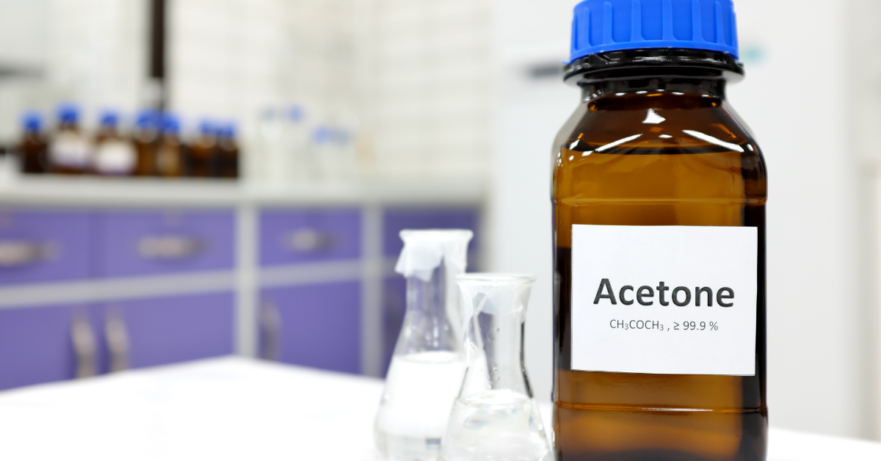Many solvents are used in an industrial space. Solvents can be used during the manufacturing process, to help with processes such as cleaning equipment, removing stains or marks, dissolving material, as well as sanitizing surfaces.
One of the more common solvents used in a variety of industries today is Acetone. These include flooring, paint, coatings, cabinetry, and fiberglass manufacturing.
With a large demand for acetone and a tightening of supply recently, the price of virgin acetone is subject to increase. To help save on costs, businesses can choose to purchase recycled acetone or use solvent recovery equipment on site to maximize the lifespan of their supply.
In this blog, Maratek will be breaking down what acetone is as a solvent, and how it is used within different industries.
What is acetone?
Acetone is a clear, volatile substance that is highly-flammable as a liquid and a vapor. Acetone is commonly referred to as propanone or dimethyl ketone (DMK). Its chemical formula is CH3COCH3.
The substance has a very distinct scent that is described as sweet. This volatile substance is polar and can easily form homogenous mixtures with water and different organic compounds, which makes it an effective solvent. Another attractive feature is the low boiling point that allows it to easily evaporate.
How is it produced?
Acetone is a manufactured chemical from benzene and propylene. Both materials are used to produce cumene, which further oxidizes to become cumene hydroperoxide. Following this process, it is then split into phenol and acetone.
It is the simplest of ketones produced when insulin levels are low, and is effective at dissolving fats, resins, and cellulose. Commercial acetone can also be produced through the dehydrogenation of isopropyl alcohol.
Safety measures for acetone include proper storage and containment due to its flammable properties. It is beneficial to use explosion-proof equipment to lessen the risks. It is also classified as a severe eye irritant, so proper PPE should be used as a precaution. Inhalation of the fumes may also cause a sore throat or cough.
How is acetone used?
Acetone has many uses but is commonly used to clean equipment or as a solvent during production or manufacturing. Acetone is used with fats, oils, waxes, resins, rubber, plastics, lacquers, and varnishes. Any leftover acetone will evaporate due to it’s low boiling point, leaving the surfaces clean.
Although acetone is used prominently as an industrial solvent and cleaner, it is also used in some household products. Nail polishes, nail polish remover, hair colours, hair tonics, sun tan, are all common household products that acetone is an ingredient in.
To help further understand specific applications of acetone, looking at the furniture and window, flooring, cabinetry, and fiberglass manufacturing industries will provide real examples of it’s different uses.
The furniture industry: For producers of vinyl doors, furniture, windows, and other like products, acetone is used to clean surfaces and remove any impurities or contaminants. A higher purity of acetone is typically needed to ensure that the solvent evaporates off and does not sit and potentially erode the item.
The flooring industry: Flooring companies use acetone to clean their equipment after staining the wood. An automated machine is used to stain the flooring and is needed to thoroughly clean the equipment whenever they change the colour of the stain. Acetone is again used to clean the paint and application lines of the equipment. After the cleaning is complete, the mixture of acetone and stain is typically collected and can be recycled to be reused.
The cabinetry industry: Similar to flooring, the cabinetry industry needs to clean their equipment after staining or painting the wood. One exception is that water-based or waterborne paint and stains are cleaned using acetone when a colour or stain change is required.
Fiberglass manufacturing industries: Finally, let’s take a look at manufacturers that use fiberglass in their production. This includes a variety of products including, boats, yachts, automotive panels and many more.These manufacturers tend to use acetone to clean off the surface of the product. Depending on the process, the acetone could be collected into drums and recycled, but if the acetone evaporates there is no opportunity to recycle the solvent.
Acetone recovery and recyling
There are many cost saving options available for companies when it comes to purchasing and using solvents. Virgin solvents can be very expensive for a company to consistently purchase, making recycled acetone an excellent option.
Recycled acetone is available as an alternative to reduce business costs, while at the same time also being more environmentally friendly than virgin solvent. To further save money, a company can send out their waste solvent to be recovered and returned or, they recover it in house with solvent recovery equipment.
Want to learn more about the solvent recovery and why it is a viable way to cut back on costs? Contact Maratek today. Our team of waste and solvent recovery experts are ready to assist you.

